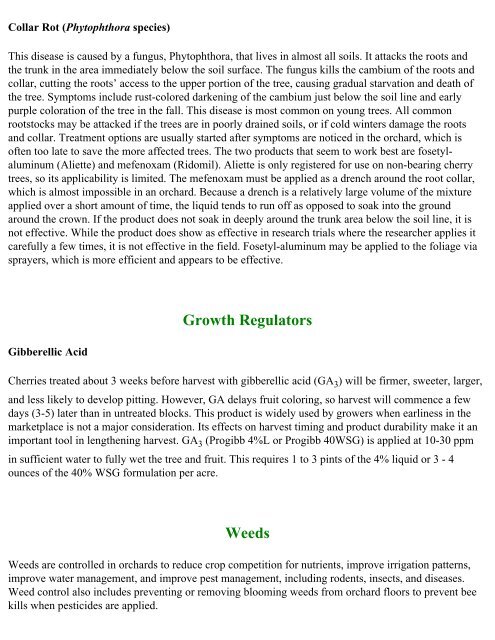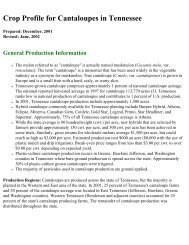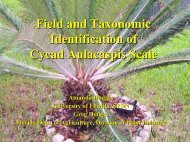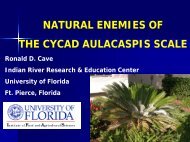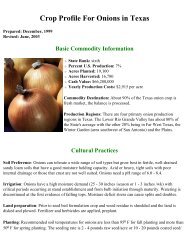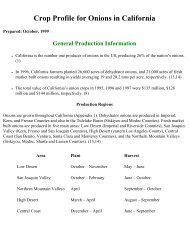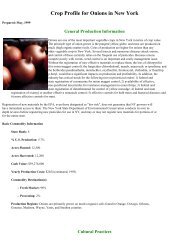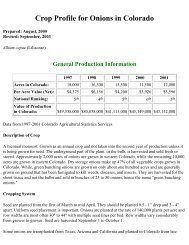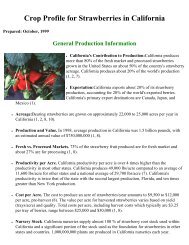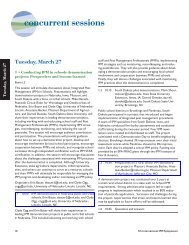Crop Profile for Cherries (Sweet) - Regional IPM Centers
Crop Profile for Cherries (Sweet) - Regional IPM Centers
Crop Profile for Cherries (Sweet) - Regional IPM Centers
Create successful ePaper yourself
Turn your PDF publications into a flip-book with our unique Google optimized e-Paper software.
Collar Rot (Phytophthora species)<br />
This disease is caused by a fungus, Phytophthora, that lives in almost all soils. It attacks the roots and<br />
the trunk in the area immediately below the soil surface. The fungus kills the cambium of the roots and<br />
collar, cutting the roots’ access to the upper portion of the tree, causing gradual starvation and death of<br />
the tree. Symptoms include rust-colored darkening of the cambium just below the soil line and early<br />
purple coloration of the tree in the fall. This disease is most common on young trees. All common<br />
rootstocks may be attacked if the trees are in poorly drained soils, or if cold winters damage the roots<br />
and collar. Treatment options are usually started after symptoms are noticed in the orchard, which is<br />
often too late to save the more affected trees. The two products that seem to work best are fosetylaluminum<br />
(Aliette) and mefenoxam (Ridomil). Aliette is only registered <strong>for</strong> use on non-bearing cherry<br />
trees, so its applicability is limited. The mefenoxam must be applied as a drench around the root collar,<br />
which is almost impossible in an orchard. Because a drench is a relatively large volume of the mixture<br />
applied over a short amount of time, the liquid tends to run off as opposed to soak into the ground<br />
around the crown. If the product does not soak in deeply around the trunk area below the soil line, it is<br />
not effective. While the product does show as effective in research trials where the researcher applies it<br />
carefully a few times, it is not effective in the field. Fosetyl-aluminum may be applied to the foliage via<br />
sprayers, which is more efficient and appears to be effective.<br />
Gibberellic Acid<br />
Growth Regulators<br />
<strong>Cherries</strong> treated about 3 weeks be<strong>for</strong>e harvest with gibberellic acid (GA3 ) will be firmer, sweeter, larger,<br />
and less likely to develop pitting. However, GA delays fruit coloring, so harvest will commence a few<br />
days (3-5) later than in untreated blocks. This product is widely used by growers when earliness in the<br />
marketplace is not a major consideration. Its effects on harvest timing and product durability make it an<br />
important tool in lengthening harvest. GA3 (Progibb 4%L or Progibb 40WSG) is applied at 10-30 ppm<br />
in sufficient water to fully wet the tree and fruit. This requires 1 to 3 pints of the 4% liquid or 3 - 4<br />
ounces of the 40% WSG <strong>for</strong>mulation per acre.<br />
Weeds<br />
Weeds are controlled in orchards to reduce crop competition <strong>for</strong> nutrients, improve irrigation patterns,<br />
improve water management, and improve pest management, including rodents, insects, and diseases.<br />
Weed control also includes preventing or removing blooming weeds from orchard floors to prevent bee<br />
kills when pesticides are applied.


